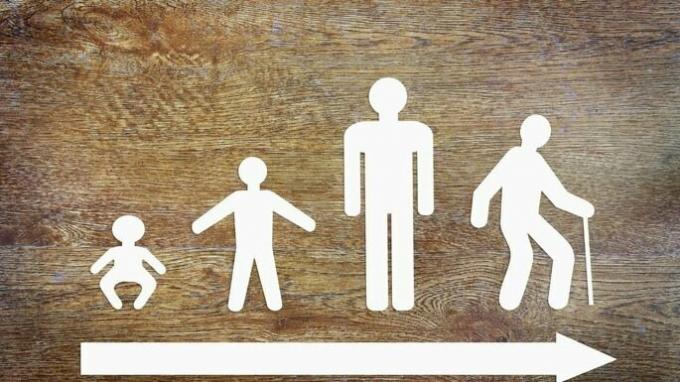Human beings go through 4 stages in life, which are: childhood, adolescence, adulthood and old age. They occur within the life cycle that has two major events: the birth and the death.
Each of them occurs in the human species from a specific age, although it is not the same for everyone. Childhood ranges from birth to 11 years of age, adolescence from 12 to 20 years of age, adulthood from 21 to 65 years of age, and old age from 65 years of age onwards.
Human beings go through several changes and the stages of the life cycle is one of them. The stages of life are subdivided and this can generate some confusion as to the exact number of stages. Therefore, it is worth clarifying that only 4 stages from childhood to old age.

In humans, as in other mammals such as cats, dogs, and lions, the changes are perceived in the alterations that occur in the body and in the behaviors and these changes are the phases of the life.
For example, if you had or saw a cat as a child, you must have witnessed many games, such as running, jumping or fighting with an object. These behaviors are natural in this species, in fact, they are hunting stimuli. However, when they reach adolescence this behavior changes, they play less and start other activities such as hunting itself. Until they become adults and become calmer, they focus their movements to be more accurate and spend less energy.
Childhood

Childhood is an important period in the life of every human being. In it, one learns to identify the world, interpret it, strengthen family ties and initiate social and learning relationships through experiences.
For some scientists this phase is divided into 3 stages:
- Early childhood: from birth to 3 years of age;
- Second childhood: from 3 to 6 years old;
- Third childhood: from 6 to 11 years old.
The end of third childhood and the beginning of adolescence is marked by accelerated changes in the body. Growth, appearance of hair, deepening of the voice, enlargement of the hips are some of them. These processes are triggered by the endocrine system, through the action of hormones.
The hormones produced by the glands act in a cascade system. For example, the pituitary gland produces two hormones, LH (Luteinizing) and FSH (Follicle Stimulating), which through the bloodstream reach the gonads, testes (boys) and ovaries (girls), which produce the hormones testosterone, estrogen and progesterone, which leads to maturation sexual.
This process is known in biology as puberty.
Adolescence

Adolescence is a phase of agitation, expansion of activities, formation of groups, identity and patterns that will be present in the individual in adulthood.
Boys, upon reaching puberty, deepen their voices, increase muscle mass and present hair in the pubic region and armpits, in addition to a beard and mustache. Girls enlarge their breasts, accumulate more fat in their thighs, widen their hips and also manifest hair in their armpits and pubic area.
Adolescence is divided into:
- Preadolescence or minor adolescence: from 11 to 14 years of age;
- Middle adolescence: from 14 to 17 years old;
- Older adolescence or youth: from 17 to 20 years old.
It is important to note that these changes may vary from organism to organism depending on genetics. It is common for girls to experience puberty earlier than for boys.
Read more about: genetics.
Adulthood

In this phase of human life, bodily changes are smaller and slower, but progressive. It is in it that important psychological changes arise, as well as the complete development of the nervous system, with the full maturation of the brain. The human being comes to understand his participation in society and in life, and offers the world everything he has built in previous phases.
The adult phase is divided into 2 stages:
- young adult: from 21 to 40 years of age;
- Middle-age: from 40 to 60 years.
The human body between 30 and 40 years of age reaches the peak of its development. To understand better, think of a flower. It starts its life cycle all wrapped up and, little by little, it starts to open up, right? And when it blooms, it is completely open, that is, it reaches its maximum development. So is the human being at this stage, like an open flower, at its peak.
Old age

After their maximum development the flowers begin to wither, the same happens with the human being. In old age, the body undergoes slow changes, but not as in adulthood, but the opposite.
The definition of old age is a matter of debate, because of the improvement in the quality of life that technology and advances in healthcare have provided. More and more people reach the age of 65 healthy and still in the job market.
Some scientists divide old age into two stages:
- Young elderly: from 65 to 75 years of age;
- Older Elder: above 75 years.
The human being, as he advances in this stage, feels the body, little by little, decrease the capacities, such as agility, reflexes, hearing, vision, etc. In addition to changes in physiology, that is, in the functioning of the body, such as the heart beating at a lower frequency than that of a 35-year-old adult.
Read more about:
- endocrine system
- Puberty
- hormones
Bibliographic references
GONÇALVES, J. P. Life Cycle: Beginning, Development and End of Human Life Possible Contributions for Educators. Context & Education Magazine, v. 31, no. 98, p. 79, 2016.
LOURENÇO, B.; QUEIROZ, L. B. Pubertal growth and development in adolescence. Medicine Journal, v. 89, no. 2, p. 70–75, 2010.
PAIVA, V. M. B. Old age as a stage of human development. Rev. psychological, v. 4, no. 1, p. 15–23, 1986.
PASSION, C. G et al. Ontogeny: From birth to old age. Journal of Psychophysiology, v. 2, p. 1–13, 2005.


